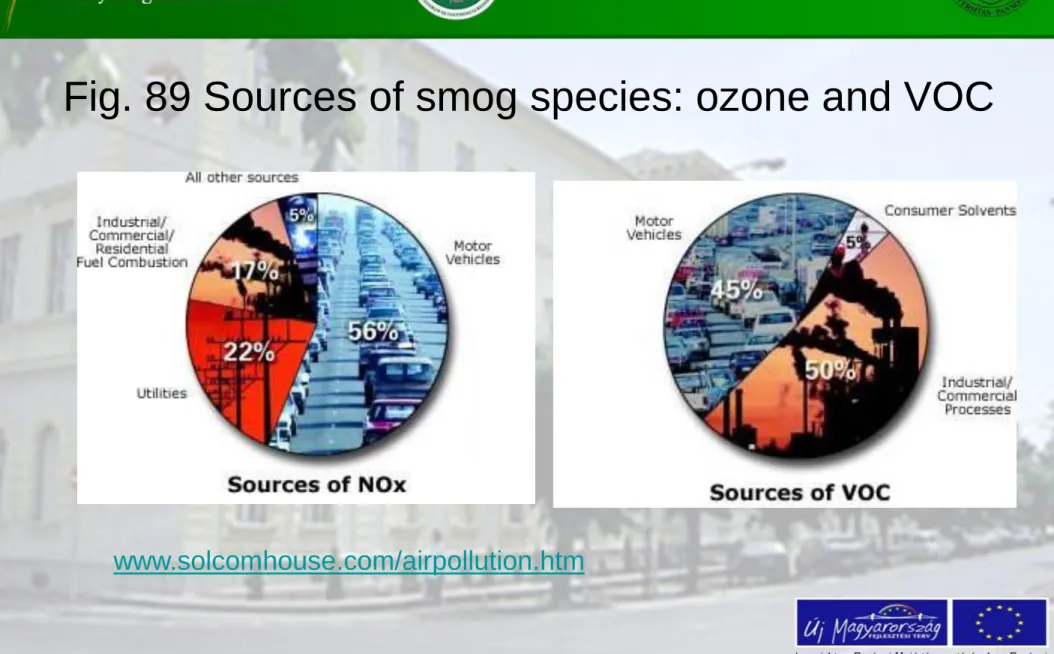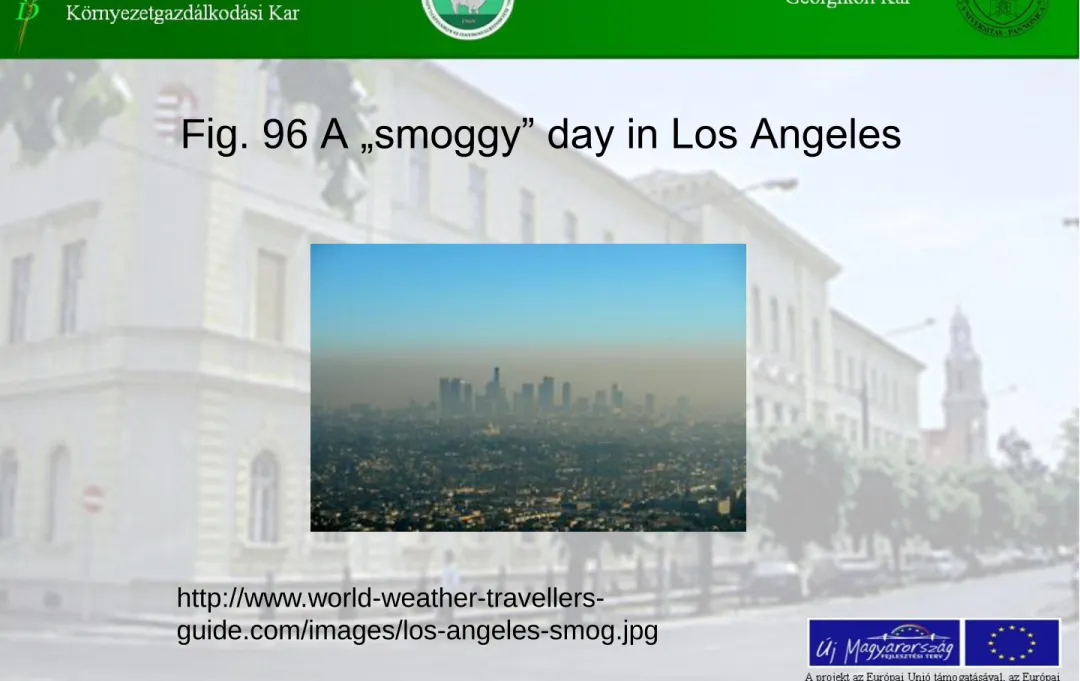Tananyag fejlesztés idegen nyelven
Prevention of the atmosphere
KÖRNYEZETGAZDÁLKODÁSI AGRÁRMÉRNÖKI MSC
(MSc IN AGRO-ENVIRONMENTAL STUDIES)
Atmospheric chemical reactions II.
The tropospheric ozone
Lecture 13
Lessons 37-39
Lesson 37
Environmental contamination: from local to global level. Impact of ground level ozone
– introduction of photochemical smog
formation
• The contaminant transmission in the atmosphere includes two important sub-processes:
- transformation of pollutant in the air (chemical and physical reactions, where the chemical ones are the dominant ones). The atmospheric chemistry is dealing with this subject.
- The second part is the transport process and
dispersion of pollutant in the atmosphere. This latter contains the modeling of contaminants.
Our theme will be transformation at first; later on, in the next lecture we continue with modeling of pollutant.
From global to local level environmental effects
The impact of pollutant strongly depends on the residence time of the causing agent. If the residence time of a
contaminant is low, its spatial impact is local. These
particles are highly reactive species; they transform very quickly after their emission.
The next group of contaminants remains in the atmosphere for a long time period. Their residence time is longer,
sometimes may reach even the decades or more. The long lifetime of these particle makes it possible to reach far distances in the atmosphere, sometimes to get
around the Earth; or vertically higher sphere.
On their way chemical transformations may occur.
• An example for the global level process is given by stratospheric ozone depletion. The timescale of the vertical transport from the troposphere to the
stratosphere varies from 7 to 10 years. The residence
time of CFCs reach these values as they vary from years to some hundreds of years in CFC-11 (2 years) and
CFC-13 (640 years), respectively. This variable in case of HCFCs is a little shorter due to added H atom;
minimum half of the lifetime of the CFCs. These
compounds produces the chloride and bromide after their photolysis see also earlier lecture.
Ozone in the troposphere
• Returning back to local level pollutants, we find that the ozone’s short residence time in the troposphere strongly depends on radiation level.
Table 13 The temperature dependence of ozone lifetime
(Seinfeld and Pandis)Season 20° N 40° N
Summer 5 days 10 days
Winter 15 days 100 days
• The result is obvious; the less the incoming radiation, the higher the ozone lifetime in the atmosphere. This causes a special geographical distribution of tropospheric ozone concentration.
• High ozone concentrations influences the human activities (largely the combustion of fossil fuels;
gasoline, diesel, etc), and this pollutant is also the
constituent of the Los Angeles smog. It is important to mention, that the ozone has two different roles
depending on the gas vertical position in the air. The tropospheric ozone is a very toxic agent, harms our health.
Role of ground-level ozone in chemical reactions
• It is well known, that the ozone is a powerful oxidizing
gas reacting with other chemical compounds of the lower atmosphere producing many possibly toxic oxides.
Ground-level ozone is less concentrated than ozone aloft; their impact is also completely different.
• The tropospheric ozone belongs to the greenhouse gases. It induces the chemical removal of other
atmospheric constituents as methane and other hydrocarbons from the atmosphere. Thus, its
concentration affects how long these compounds remain in the air.
• There are three ozone precursors in the lower
atmosphere: NOx, CO, and VOCs. Radiation is also needed to the process. Without NOx the VOCs do not favor the ground-level ozone formation.
• Sources of the precursors of ground-level ozone:
- Motor vehicle exhaust, - industrial emissions, - chemical solvents
Although these agents often originate in urban areas, winds carry the nitric oxide hundreds of kilometers. The result is the appearance of ozone on less populated regions.
Fig. 89 Sources of smog species: ozone and VOC
www.solcomhouse.com/airpollution.htm
• At pollutions of local level, the Non-Methane VOC expression is used because in ground-level ozone formation other than methane are dominant species.
Globally the impact of methane has of primary importance.
• There are a lot of chemical reactions involved in tropospheric ozone formation. Complex cycles are present, where carbon monoxide and VOCs are transformed to water vapor and carbon dioxide.
• In the next slides we discuss the NOx and ozone formations together with other oxidizing reactions.
• Production of NOx on ground level
1. The initial gas in the nitric oxyd production is the nitrogen molecule of the air,
N2 + O- → NO + N, N + O2→NO + O-, N + OH- →NO + H.
The final result of the above reactions will be:
N2 + O2 → 2NO.
This chemical reaction may happen at high temperatures only due to high activation energy. The name of the result is thermal NO.
2. This group contains hydrogen atom (the form in our example CH) including free radicals. The name of the nitric oxide is prompt NO. In this process the activation energy is low.
CH + N2 → HCN + N The HCN accounts for CN formation, HCN + H → CN + H2, and HCN + OH- → CN + H2O.
The reactions lead to HCN and CN (radicals) and they take part in formation of NO.
3. At high pressures the N2O may also be produced
Lesson 38
Catalyzed tropospherical ozone formation
Formation and depletion of tropospheric ozone
• The ozone formation is completely different in the ground level. In stratosphere we know, that way is,
O2 + O + M → O3 + M.
The nascent oxygen comes from photolysis of molecular oxygen,
O2 + hν (λ ≤ 242 nm) → O- + O-.
In the ground level the only source of nascent oxygen is the photolysis of the nitrogen dioxide,
NO2 + hν(300 nm ≤ λ ≤ 400 nm) → NO + O-.
The close connection between NO and ozone may be explained by this reaction.
• Ozone destruction takes place by oxidizing the NO, NO + O3 → NO2 + O2.
The quasi steady-state assumption for NO, results the photo stationary equilibrium:
Where J denotes the photolytic rate and k stands for kinetic rate.
NO
k
NO O3 J 2
• The equilibrium equation is applied in ozone projections.
When the ratio is high, the amount of ozone is
increasing. At low ratio the destruction of the ozone molecules may be waited.
Catalyzed ozone formations in the troposphere
Three gases in the troposphere induce the above oxidation processes
- Non-Methane VOCs - methane and
- carbon monoxide.
• Hydrocarbon oxidation
Let RH stand for generic hydrocarbon! The NOx acts as a catalyzer. Oxidizing actions by OH- lead to other radical formations such as peroxyl radical (RO2) or oxy radical (RO) or aldehyde radical (R’CHO). R’ means in the chain a lower number of carbon atom than the initial was.
The oxidation with NOx catalyzer takes place as, RH + OH →R + H2O,
R + O2 + M → RO2 + M, RO2 + NO → RO + NO2, RO+O2 → RCHO+HO2,
HO2 + NO- → OH- + NO2.
• In the end of this chain the hydroperoxyl oxides the NO into NO2. One molecule RH is responsible for two
molecules of nitrogen dioxide.
• The source of ozone will be therefore the NO2, NO2 + hν → NO-+ O-,
O2 + O- + M → O3 + M.
The global budget is than
RH NOx → R’CHO+ 2O3.
• Final reactions finishing the oxidation chain are, HO2 + HO2 → H2O2 + O2,
NO2 + OH- + M → HNO3 + M.
Both the hydrogen peroxyde and nitric acid are stable compounds.
Methane oxidation
The steps of the oxidation are as follows, CH4 + OH → CH3 + H2O,
CH3 + O2 + M →CH3O2 + M, CH3O2 + NO → CH3O + NO2, CH3O+O2 → HCHO + HO2.
• Photolysis of formaldehyde is the next step, HCHO+ hν O2 → CHO+HO2,
CHO + O2 → CO + HO2, CO+OH- →CO2 + H,
H+ O2 + M→ HO2 + M.
The peroxi radical takes part in production of NO2, HO2 + NO → NO2 + OH-
The nitrogen dioxide acts in the formation of the ozone molecules through the above equations,
NO2 + hν → NO + O-,
O2 + O- + M → O3 + M.
In case of methane cycle the global budget is CH4 NOx → CO2 + 5O3 + 2OH-
One molecule methane is responsible for producing five molecules ozone.
• CO oxidation
The efficiency of CO in ozone production is less because the carbon monoxide does not contain hydrogen. The oxidation is,
CO+OH- →CO2 + H,
H + O2 + M → HO2 + M.
• Finally the ozone production is available through the HO2 use, when the peroxy radical oxides NO to NO2,
HO2 + NO → OH + NO2, NO2 + hν → NO + O,
O2 + O + M → O3 + M, And the global budget is
CO NOx → CO2 + O3.
The result is not very efficient; one carbon monoxide produces only one ozone molecule.
• Previously, the oxidation chains assumed abundant NOx concentrations. In this case the prevailing reaction is
HO2 + NO → OH- + NO2
forming huge amount of ozone in the ground level.
When the NOx level is low, it may hinder the ozone production due to lower oxidizing capacity of the
surroundings. Here the last step in oxidation chain is HO2 + HO2 → H2O2 + O2
The dominant equation from the above two ones depends on the actual VOC – NOx ratio. Two regimes may form:
the VOC limited and the NOx limited one.
• In VOC-limited regime, a decrease in NOx concentration produces higher ozone production (oppositely to the
decreased VOC concentration);
• In NOx -limited regime, a decline in NOx results in lower ozone, but changes in VOC concentrations do not affect ozone production.
• The actual NOx level always determines the applied method in protection the air quality of urban areas (heavy traffic – NOx connection)
• European traffic emissions are estimated to be responsible for 26% of the O3 peak values.
Lesson 39
The Los Angeles smog with its leisure
Term smog and it’s history
• The smog terminology is the union of smoke and fog introduced by Henry Antoine Des Voeux in his 1905 paper, "Fog and Smoke" for a meeting of the Public Health Congress.
• The July 26, 1905 edition of the London newspaper Daily Graphic quoted Des Voeux, "He said it required no
science to see that there was something produced in great cities which was not found in the country, and that was smoky fog, or what was known as 'smog.„
Fig. 96 A „smoggy” day in Los Angeles
http://www.world-weather-travellers-
guide.com/images/los-angeles-smog.jpg
Fig. 97 The declining number of days with smog in Los Angeles
http://www.aqmd.gov/news1/2007/SmogSeason07.gif
The Los Angeles smog
• Summing the earlier cycles we note, that the NO2 transformation is not responsible alone to increased
ground level ozone formation - Los Angeles smog-, due to no net production of ozone and NO reactions. An
extra step is needed, what unbalances the
transformation on NO to NO2. The atmospheric radicals are formed from vehicle exhaust and they oxide NO into NO2. This unbalanced amount of NO2 is the source of surplus amount of ozone.
• Some „by-products” are also present: aldehydes, ketons, PAN and particulates.
Table 14 Scheme of Los Angeles smog formation
• The Los Angeles smog is also called as photochemical smog, or oxidative smog implying the dawn of the
pollutants. Its name came from Los Angeles Bay in the Californian coast, where the vehicle density was very high in the 1970s. The amount of vehicles was at about 1500 vehicles/km2 at that time. Not only the geographical position, but the weather also favores to smog formation in Los Angeles on few periods of the year:
- Subtropical anticyclone with clear sky - No or weak wind
- High radiation
- Subsidence inversion
• The favourable circumstances for Los Angeles smog
formation are not place specific for Californian coast; this smog can be found in all over the world. The frequency of smog appearance may differ; it is restricted for
summers mainly, as the solar radiation is indispensible to photochemical smog formation.
• Seasonal variation of Los Angeles smog of a
geographical place is determined by sunshine hours completely.
• Daily change in oxidative smog attendance is defined with vehicle exhaust as well.
Areas strongly affected by Los Angeles smog
• The oxidizing smog is especially prevalent in basins
encircled by hills or mountains. It forms in summer, when the upper air is also warm and hinders the vertical air
motions. The most touched large cities are as follows:
New Delhi, New York, Cairo, Los Angeles, Sacramento, São Paulo, Mexico City, Santiago of Chile, Toronto, Athens, Beijing, Shanghai, Manila, Hong Kong, Seoul, the Randstad or Ruhr Area, Atlanta, Houston, Phoenix, Las Vegas.
In the above places the smog can build up to dangerous levels.
Influences of Los Angeles smog
• It is known, that the photochemical smog has both sides of a local pollution problem and global-scale
environmental issue. We focus on local symptoms only.
• Wide human impacts may be observed in urban areas endangered by smog.
1.The respiratory system: decrease the lungs' working
capacity, cause shortness of breath, pain when inhaling deeply, wheezing, and coughing.
In more serious cases - emphysema, bronchitis, asthma.
2. Impacting the mucus membrane: eye and nose irritation, dry out the protective membranes (nose and throat)
Because of their physiology, children are much more likely than adults to develop smog-related lung damage.
3. Attacking of the immune system.
Interferes with the body's ability to fight infection, increasing susceptibility to illness.
The so called „smog complex" involving eye irritation, irritation of the respiratory tract, chest pains, cough,
shortness of breath, nausea and headache can be found when oxidizing smog attends.
Fig. 98 Injury of Los Angeles smog on plants
http://www.apec-
vc.or.jp/e/modules/tinyd01/index.php?id=25





